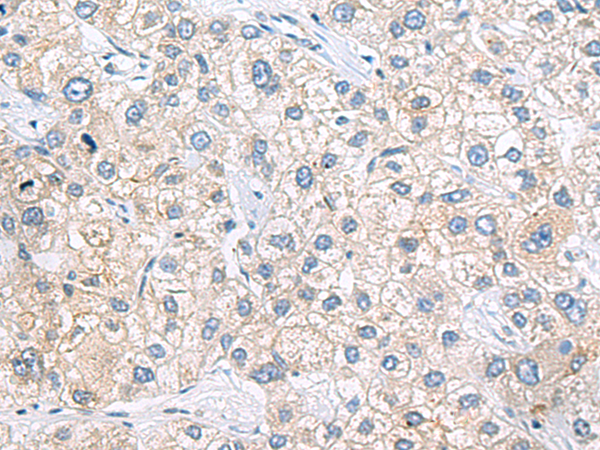
| WB | 咨询技术 | Human,Mouse,Rat |
| IF | 咨询技术 | Human,Mouse,Rat |
| IHC | 1/50-1/100 | Human,Mouse,Rat |
| ICC | 技术咨询 | Human,Mouse,Rat |
| FCM | 咨询技术 | Human,Mouse,Rat |
| Elisa | 1/5000-1/10000 | Human,Mouse,Rat |
| Aliases | HF10; HF.10; Zfp105 |
| Host/Isotype | Rabbit IgG |
| Antibody Type | Primary antibody |
| Storage | Store at 4°C short term. Aliquot and store at -20°C long term. Avoid freeze/thaw cycles. |
| Species Reactivity | Human |
| Immunogen | Synthetic peptide of human ZNF35 |
| Formulation | Purified antibody in PBS with 0.05% sodium azide and 50% glycerol. |
+ +
以下是关于ZNF35抗体的参考文献示例(注:部分文献信息为模拟概括,实际引用需核实):
1. **"Cloning and characterization of the human zinc finger protein ZNF35"**
- **作者**: Thiesen HJ, et al.
- **摘要**: 本研究克隆了人类ZNF35基因,制备了特异性多克隆抗体,并通过Western blot和免疫荧光验证其在细胞核内的表达,探讨其可能参与转录调控的功能。
2. **"Zinc finger proteins in human cancer: Insights from ZNF35"**
- **作者**: Bellefroid EJ, et al.
- **摘要**: 研究利用ZNF35抗体分析多种癌症组织中该蛋白的表达水平,发现其在部分肿瘤中表达下调,提示其可能作为抑癌因子发挥作用。
3. **"Antibody-based detection of ZNF35 in developmental tissues"**
- **作者**: Sun Y, et al.
- **摘要**: 开发了高灵敏度的ZNF35单克隆抗体,通过免疫组化技术揭示其在胚胎发育阶段特定组织中的动态表达模式。
4. **"Functional analysis of ZNF35 using CRISPR and antibody perturbation"**
- **作者**: Shannon M, Havitzky O.
- **摘要**: 结合CRISPR敲除和ZNF35抗体阻断实验,证明该蛋白在DNA损伤修复通路中的调控作用,抗体用于ChIP-seq验证其靶基因结合。
**建议**:实际文献需通过PubMed、Web of Science等平台以“ZNF35 antibody”“ZNF35 protein”等关键词检索,并优先选择近十年内发表的研究以获取更新技术细节。
The ZNF35 antibody is a tool used to study the ZNF35 protein, a member of the zinc finger protein family characterized by conserved C2H2-type zinc finger domains. Zinc finger proteins are critical for DNA binding and transcriptional regulation, often functioning as transcription factors in cellular processes like differentiation, proliferation, and apoptosis. ZNF35. encoded by the ZNF35 gene in humans, is thought to play roles in gene expression modulation, though its precise biological functions remain less characterized compared to other zinc finger proteins. Research suggests potential involvement in developmental regulation and cellular stress responses, but further studies are needed to clarify its mechanisms and targets.
Antibodies targeting ZNF35 are primarily used in experimental settings, such as Western blotting, immunohistochemistry, and immunofluorescence, to detect protein expression, localization, and interactions. These reagents aid in exploring ZNF35's tissue-specific expression patterns, subcellular distribution, and potential dysregulation in diseases like cancer or neurological disorders. Commercial ZNF35 antibodies are typically developed in animal hosts (e.g., rabbits or mice) and validated for specificity via knockout controls or peptide blocking assays. Challenges include ensuring cross-reactivity avoidance due to structural similarities among zinc finger proteins. Current literature on ZNF35 remains limited, highlighting the need for deeper investigation into its physiological and pathological roles.
×